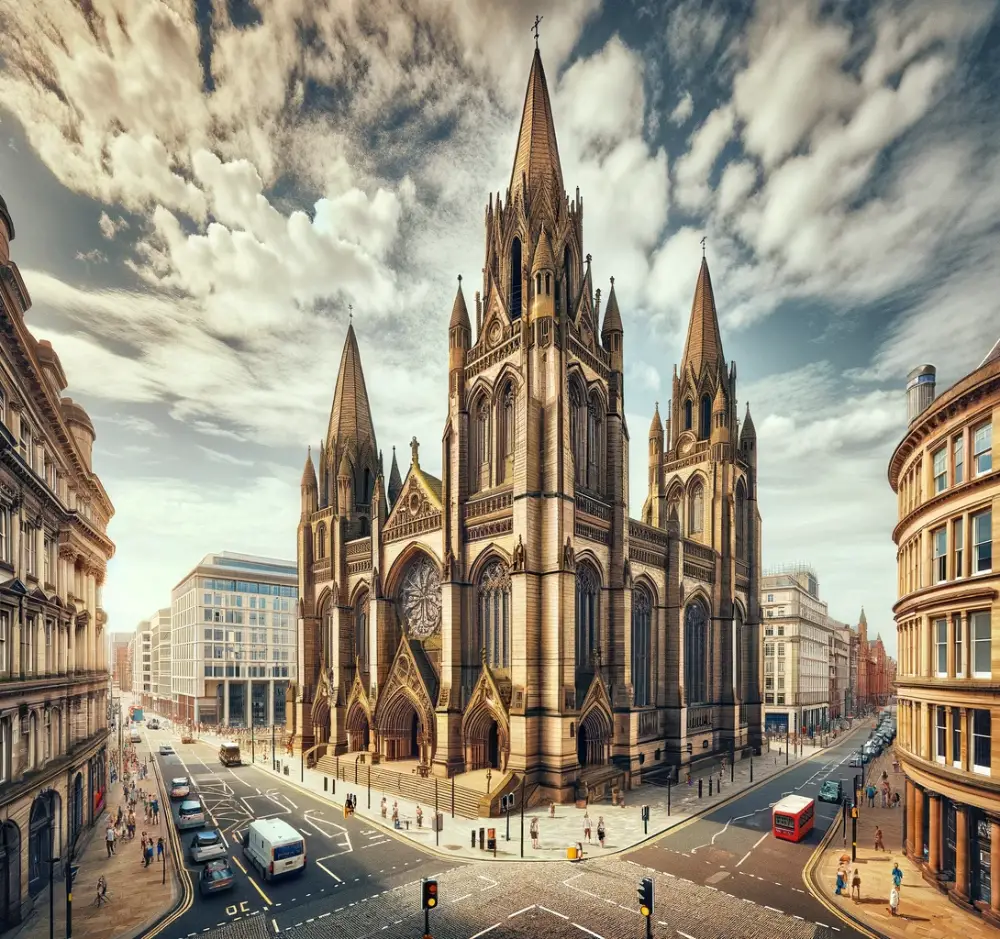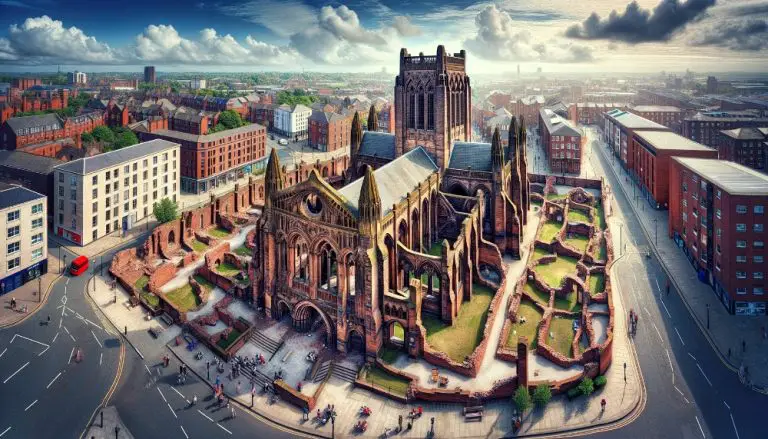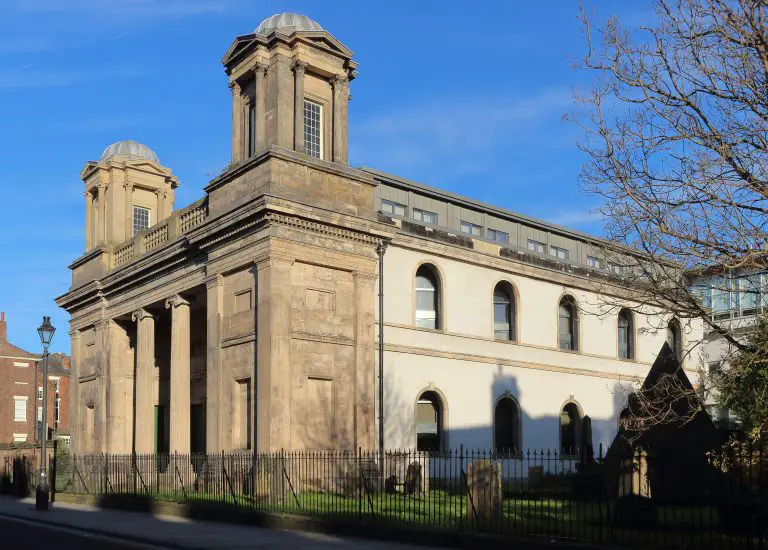Church of St. Vincent de Paul in Liverpool

The Church of St. Vincent de Paul in Liverpool is a vibrant Catholic parish that has been serving the community since 1852. Situated in the heart of Liverpool, this historic church embodies the spirit of the Catholic faith and is a place of worship, community, and spiritual growth.
A Historical Foundation
The Church of St. Vincent de Paul was established in 1852 to cater to the predominantly Irish population residing in the docklands of Liverpool. This Catholic Church held four Masses every Sunday and two Masses every weekday to accommodate the spiritual needs of the large community, which comprised over 7,000 individuals. It played a significant role in the lives of the Irish immigrants, offering them a place of worship and providing spiritual guidance.
Transition and Resilience
In the 1960s, the Irish population of Liverpool faced significant challenges with slum clearances, resulting in the eviction of many residents from their homes. This, coupled with the decline of local employment due to the relocation of the docks, had a profound impact on the community. However, despite these hardships, the Church of St. Vincent de Paul demonstrated remarkable resilience and determination to continue serving its faithful.
During this tumultuous period, a core group of believers within the church emerged as beacons of hope, rallying the community and providing support and encouragement. These individuals, deeply committed to their faith, worked tirelessly to ensure that the Church of St. Vincent de Paul remained a steadfast presence in the lives of its members.
Additionally, the church received invaluable assistance from priests from neighbouring parishes, who recognized the importance of preserving this spiritual sanctuary in the face of adversity. Their support and collaboration provided vital resources and guidance, ensuring the survival of the Church of St. Vincent de Paul during these challenging years.
Through resilience, determination, and the unyielding faith of its members, the Church of St. Vincent de Paul weathered the storm of slum clearances and the decline of local employment. It stands as a testament to the enduring power of belief and community, offering solace and support to all who seek spiritual nourishment within its walls.
Architectural Beauty and Significance
The Church of St. Vincent de Paul is a stunning example of Gothic Revival architecture. Designed by the renowned architect E. W. Pugin, the church showcases the grandeur and intricacy of this architectural style. Constructed between 1856 and 1857, the church stands as a testament to the vision and skill of its creators.
At its core, the Church of St. Vincent de Paul is a Grade II* listed building, highlighting its historic importance and architectural significance. This designation acknowledges the enduring beauty and cultural value of the church.
The church’s construction materials of stone and slate roofs not only contribute to its visual appeal but also ensure its durability and longevity. From the finely carved details to the soaring spires, every aspect of the church’s design reflects the craftsmanship and technical expertise of its builders.
The Gothic Revival style, popular in the 19th century, draws inspiration from medieval architecture, particularly the 13th century. The result is a place of worship that exudes a sense of awe and reverence. From the intricate ornamentation to the soaring vaulted ceilings, the architectural details of the Church of St. Vincent de Paul are a testament to the dedication and talent of its creators.
As you step inside, you are greeted by a space that is both grand and intimate. The nave, with its towering pillars and stained glass windows, creates a sense of transcendence. The chapels and altars feature exquisite reredos, showcasing the artistry of the era.
Architectural beauty and significance: “The Gothic Revival style of the Church of St. Vincent de Paul stands as a visual testament to the craftsmanship and dedication of its builders. Its Grade II* listed status is a testament to its historical and cultural importance.”
Interior Grandeur
Step inside the Church of St. Vincent de Paul, and prepare to be captivated by its breathtaking grandeur. Every corner of this magnificent church is a testament to the beauty of faith and devotion. With its impressive architecture and stunning design, the interior of St. Vincent de Paul offers a truly awe-inspiring experience.
Nave and Aisles
The spacious nave of the church is a sight to behold. Bathed in natural light from the clerestory windows, it creates an atmosphere of tranquility and reverence. The north and south aisles flank the nave, inviting worshippers to explore and immerse themselves in the sacred space.
Chancel and Chapels
The chancel, adorned with exquisite arcades, stands as the focal point of the church. It is a place of prayer and contemplation, where worshippers can feel a deep connection to their spirituality. Accompanied by the north and south chapels, the chancel provides intimate spaces for reflection and devotion.
Arcades and Altars
The arcades within the church are a true marvel. Supported by octagonal piers with intricately carved capitals, they showcase the craftsmanship and attention to detail that went into the design. Marvel at the intricate patterns and motifs that adorn these architectural wonders.
The altars within the chancel and chapels are crafted from exquisite marble, adding an air of elegance and reverence. Each altar is complemented by a stunning reredos, serving as a visual representation of the divine presence within the church.
Stained Glass Windows
One cannot help but be drawn to the vibrant colors and intricate details of the stained glass windows that grace the walls of St. Vincent de Paul. Some of these stained glass windows date back to 1925, showcasing the rich history and artistic heritage of the church. They bathe the interior in a warm glow, inviting worshippers to contemplate the stories they portray.
| Feature | Description |
|---|---|
| Nave | A spacious area with clerestory windows, filling the space with natural light |
| Aisles | North and south aisles that run parallel to the nave, creating a sense of expansiveness |
| Chancel | An ornate area adorned with beautiful arcades, serving as the central space for worship |
| Chapels | North and south chapels accompanying the chancel, providing intimate spaces for prayer |
| Arcades | Supported by octagonal piers with intricately carved capitals, creating a stunning architectural feature |
| Altars | Marble altars in the chancel and chapels, each adorned by a striking reredos |
| Stained Glass Windows | Beautiful windows with vibrant colors, some of which date back to 1925 |
Location and Directions
The Church of St. Vincent de Paul is situated on St. James Street, conveniently located in the heart of Liverpool. Its central position allows easy access for both local residents and visitors to the city. The church is nestled in close proximity to two vibrant districts, the Baltic Triangle and Chinatown, offering a rich cultural experience.
Conclusion
The Church of St. Vincent de Paul in Liverpool has a rich history and stunning architectural beauty. This Grade 2 listed Catholic church symbolizes faith and unity and has been standing since 1852.
FAQ
What is the history of the Church of St. Vincent de Paul in Liverpool?
The Church of St. Vincent de Paul in Liverpool was founded in 1852 to serve the primarily Irish population living in the docklands of the city.
How many Masses did the church hold in its early days?
At its foundation, the church held four Masses every Sunday and two Masses every weekday to accommodate the Catholic community of over 7,000 people.
How did the Church of St. Vincent de Paul overcome challenges?
Despite facing challenges such as slum clearances and the decline of local employment, the church persevered thanks to the dedication of a core group of believers and support from neighbouring parishes.
How does the church contribute to the regeneration of Liverpool?
The church aims to be a beacon of hope in the midst of regeneration, welcoming and embracing the new population in the area, including refugees, asylum seekers, and individuals seeking a new life in the city.
What is the architectural style of the Church of St. Vincent de Paul?
The church is a stunning example of Gothic Revival architecture, designed by architect E. W. Pugin. It is made of stone and features slate roofs.
What can visitors expect to see inside the church?
Inside the church, visitors will find a spacious nave, clerestory windows, north and south aisles, a beautiful chancel with arcades, and marble altars in the chancel and chapels. The interior is adorned with intricately carved capitals and stained glass windows.
What type of community does the Church of St. Vincent de Paul represent?
The church represents a welcoming and inclusive community that embraces diversity. It provides spiritual guidance and a supportive environment for individuals from various backgrounds.
Where is the Church of St. Vincent de Paul located?
The church is located on St. James Street, near the Baltic Triangle and Chinatown districts of Liverpool, making it easily accessible for both residents and visitors to the city.
What do reviews say about the Church of St. Vincent de Paul?
Visitors and members of the community praise the church’s beauty, cleanliness, atmosphere, and location, considering it a hidden gem in Liverpool.
What events and services does the church offer?
The church offers regular Masses for worship and spiritual reflection. It also hosts special events and community activities, including concerts, retreats, and social gatherings.
What is the main purpose of the Church of St. Vincent de Paul?
The church serves as a place of spiritual guidance, worship, and a vibrant community that welcomes individuals seeking solace, a sense of belonging, and a place to foster their Catholic faith.
Source Links
- https://en.wikipedia.org/wiki/Church_of_St_Vincent_de_Paul,_Liverpool
- http://www.stvincentsparish.org.uk/
- https://www.tripadvisor.co.uk/Attraction_Review-g186337-d21225912-Reviews-Catholic_Church_of_St_Vincent_de_Paul-Liverpool_Merseyside_England.html
- The History Behind Liverpool’s You’ll Never Walk Along - February 16, 2024
- The History of Everton FC - February 16, 2024
- The History of Liverpool FC - February 16, 2024



